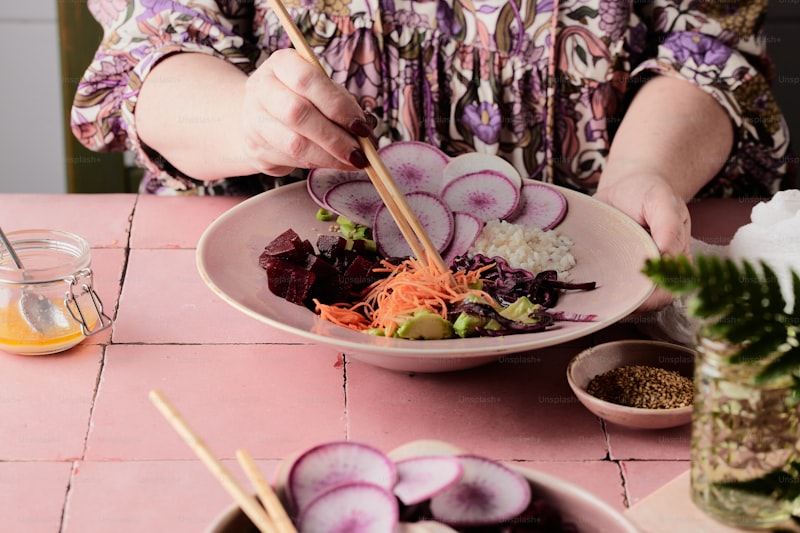#EatTheRainbow is one of the most popular hashtags on a yogi’s social media feed, but what does it actually mean? We’ve talked about the importance of eating red and orange foods and now we’ll turn our focus on the benefits of including yellow foods in our diet.
Yellow foods are generally characterized by the content of carotenoids, bromelain, limonoids, lutein and zeaxanthins. Let’s explore what exactly this means and how yellow affects you when you when you eat the rainbow.
Eat The Rainbow: Yellow
1) Carotenoids
Although carotenoids are synthesized by plants and microorganisms, they can also be found in some animal tissues. Xanthophyll is a type of carotenoid and a pigment that gives plants their colour and is also in charge of converting sunlight into energy. Three common xanthophylls found in yellow foods are lutein, zeaxanthin, astaxanthin. For instance, the characteristic yellow in egg yolk comes from two xanthophylls: lutein and zeaxanthin.
Xanthophylls have been observed to have cancer fighting properties. Among the functions that these compounds have, and that can potentially be cancer preventing, are:
- The reduction of DNA damage by increasing its repair
- Increased apoptosis, which is the elimination of cancer cells
- Inhibition of tumour and blood vessels that feed tumours growth.
- It has also been observed to boost the immune system and to reduce inflammation.
Therefore, people who have a greater dietary intake of plants rich in xanthophylls have a lower risk of developing skin, lung, breast and ovarian cancer.
See Also: Yoga and Breast Cancer: Good for Every Step of the Journey
2) Limonoids
In laboratory tests with animals and with human cells, limonoids, extracted from citrus fruits, have been shown to help fight cancers of the mouth, skin, lung, breast, stomach and colon.
Research has found that limonin may lower cholesterol. A study showed that when exposed to limonin, human liver cells demonstrated lower cholesterol levels. Having high cholestrerol are linked to increased risk of heart disease and other health problems.
The search for limonoids started long back when scientists started looking for the factor responsible for bitterness in citrus. The term limonoids was derived from limonin, the first tetranortriterpenoid (say that three times fast!) obtained from citrus bitter principles. Ongoing studies show that limonoids are highly oxygenated and have a range of biological activities like antibacterial, antifungal, antimalarial, anticancer, antiviral and a number of other pharmacological properties on humans.
Experimental evidence has revealed that limonoids present in citrus fruits and their juice have cancer chemo-preventive property, limonoids have been shown to inhibit the growth of oestrogen receptor-negative and -positive human breast cancer cells in culture.
3) Bromelain
Pineapples are rich in bromelain which is an enzyme that has been associated to help reduce swelling or inflammation in the body. Bromelain could be helpful for people who have had an injury, are recovering from a surgery or suffer from arthritis. In these cases this enzyme could be helpful to reduce pain and improve knee function in people with arthritis.
See Also: Navigating an Injury: Don’t Let It Get between You and Your Mat
4) Zeaxanthin and Lutein
The two major carotenoids in the human macula and retina are lutein and zeaxanthin, and they are often referred to as xanthophylls, or macular pigment. Yellow corn is rich in zeaxanthin which is named after the scientific name of corn: Zea mays. Zeaxanthin is one of the most common carotenoids found in plants. In humans, it has been linked with improved eye health. Another of carotenoid that gives corn its characteristic yellow colour is lutein. Like zeaxanthin, it is found in the human eye (retina) where it serves as an antioxidant, protecting the eye from oxidative damage produced by blue light.
Other yellow foods rich in antioxidants like lutein are squash and gold kiwi. Squash contains very high levels of vitamin A, including carotenoid phytonutrients like lutein and zeaxanthin. On the other hand, yellow or gold kiwis are not only high in lutein but are also a rich source of vitamin C (even more than green kiwis). A cup of sliced kiwi gives about 200mg of vitamin C, which is essential for healthy skin, teeth and bones, and is a powerful antioxidant.
Other yellow fruit and veggies to include in their diet, because of their high nutritional value, are turnips, yellow figs, yellow apples, yellow beets, and yellow bell pepper.
Foods To Help Absorb Your Yellow!
All of these compounds are soluble in fat which is why it’s so important to consume your fruits and vegetables along with a source of dietary fats such as avocado, olive oil, seeds, nuts or fatty fish. According to a study from the American Journal of Clinical Nutrition no absorption of carotenoids was observed when salads and no sources of fat were consumed. Meanwhile, a substantially greater absorption of carotenoids was observed when salads were consumed with a dietary fat source.
Ways to eat more yellow:
Veggies don’t have to be lunch-box exclusive. Cut them up into bite size portions to have ready as snacks, drizzle over your salad or scrambled eggs. Add colour to your sandwiches and wraps by adding extra veggies.
To increase the intake of fruit and veggies check this example:
Breakfast: Begin with a fruit so that the nutrients will be absorbed more efficiently. Also, add colour to your toast. You can top it up with your favourite veggies and don’t forget about the yellow touch and a bit of fat to increase the nutrient absorption.
Mid-morning snack: Munch your favourite raw vegetable crudités- such as yellow cherry tomatoes or slices of yellow bell pepper.
Lunch: Add a side salad, to your lunchtime sandwich or vegetable soup.
Mid-afternoon: snack Ditch the biscuits for fresh pineapple or melon slices.
Dinner: Indulge in a spicy chilli or hearty winter casserole packed full of seasonal vegetables.
Throughout the day: Include water and every now and then add a fresh splash of lemon to increase your limonin and vitamin C intake.
Don’t forget to include that yellow glow in your meals every day to help you eat the rainbow. You are what you eat and the nutrients that make it into our bloodstream make a difference to how you feel, how you look and even in your yoga practice. Diversify the types of fruits and veggies you eat and dare to try new shapes and tastes!













